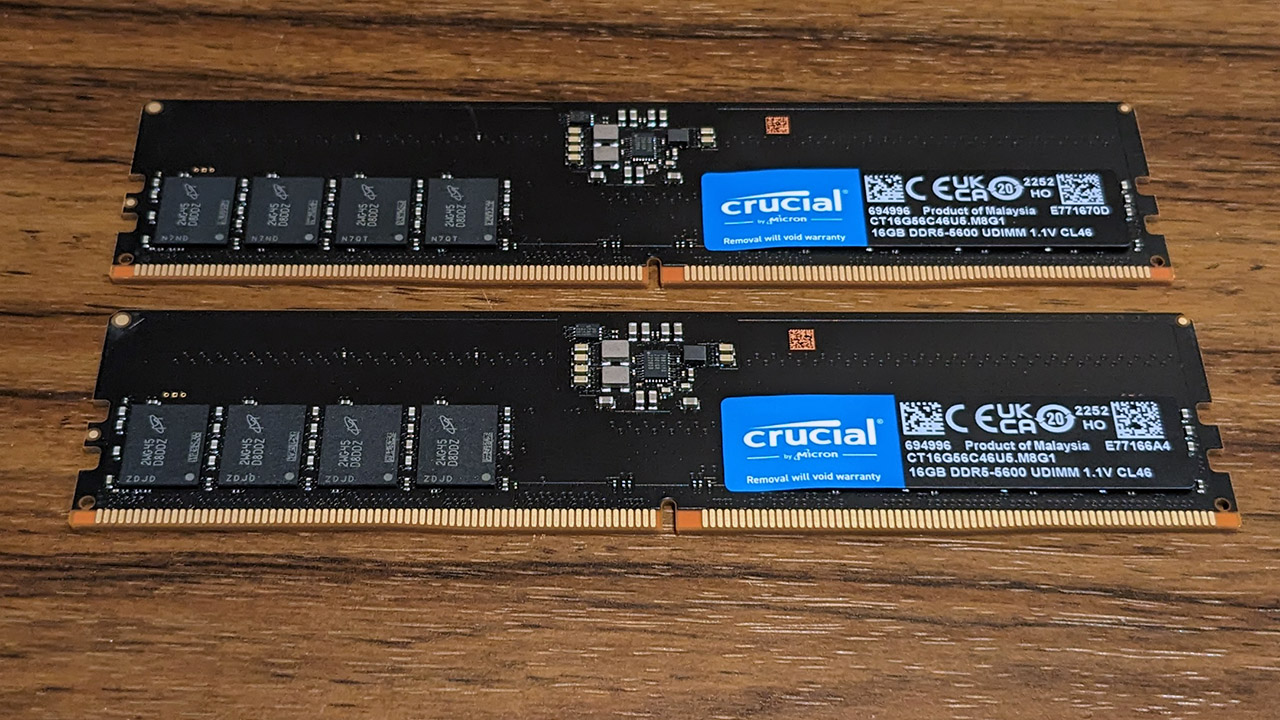
It's... generic.
DDR5 memory has come a long way since its inglorious launch. Component shortages meant DDR5 was scarce and the resulting high pricing seriously hampered adoption. In the 18 months or so since then, kits have drastically dropped in price, speeds have gone up, relative latencies have come down, and the competition is fiercer than ever.
Ideally, I wish I was here talking about one of Crucial’s historically well regarded Ballistix kits, but sadly, the Ballistix brand is no more. Instead I have a 2x16GB set of Crucial DDR5-5600. It’s made up of a pair of basic bland green PCB single sided sticks. That’s it. It’s the very definition of a generic kit. You won’t find fancy heat spreaders, RGB lighting or loads of hidden overclocking potential.
But you may well find it at the heart of a host of pre-built gaming PCs, however.
Firstly, a look at the specs of the kit. At 5600MHz, the kit conforms to the latest JEDEC compliant speed, and is officially certified to support Intel’s 13th Gen Core series processors. That might not mean a lot to enthusiast PC users, but for system builders looking for low risk and wide compatibility, it’s the kind of kit that’s perfect for the job.
Other key specs include unimpressive timings of 46-45-45-135, but the low operating voltage of just 1.1v is well under what typical enthusiast tier kits typically run at. This Crucial kit is unexciting—in terms of looks and on-paper spec.
The modules are single sided, and with its 1.1v operating voltage and relatively low speed, it’s sure to be a good option if you’re looking to upgrade a basic OEM system with something that will work out of the box. My Z790 Aorus Master motherboard detected the kit and set the timings and speed with no user input at all, and that alone is probably the highlight of the kit for entry-level users.
Inevitably the kit uses Crucial’s parent-company Micron’s D8DDZ chips. Its model number is CT2K16G56C46U5. Micron clearly can’t or won’t compete with the best Hynix chips you’ll find in 7000MHz+ kits. In fact, I only ever saw Micron chips in the most basic 4800MHz to 5600MHz first generation DDR5 kits. Anything faster was always Samsung or Hynix.
And that pretty much covers the kit. There’s not much else to talk about. And so we come to price. It’s available for $115 at the Crucial website, though it can be found for around $103 at Newegg. It’s available in the UK for £110 or AU$206. Go back a year and you’d say that’s a good price, but the market isn’t what it was back then, and at these prices the Crucial kit is poor value. There are a heap of 2x16GB kits available for under $100 and almost all of them have tighter timings and more than a few are faster too.
System Benchmarks
With an unimpressive spec and very tough competition, the kit needs to perform. Memory manufacturers want you to spend big bucks on the latest and greatest memory modules, but unless you’re running a Core i9 13900K and RTX 4090 class system, you really don’t need anything above good value 6000MHz or 6400MHz memory—and even then, the differences are negligible in most (but not all) cases.
In typical tasks the Crucial is a step above the base 4800MHz kits, though the differences are usually visible in synthetic tests only. Handbrake is an interesting one that clearly favours faster memory.
Gaming Benchmarks
When it comes to gaming, traditionally CPU limited games will see a benefit. Again, I am surprised by the effect memory speed has in Cyberpunk 2077—a game that you’d assume to be totally GPU bound. The faster memory is clearly beneficial here.
CPU: Intel Core i9 13900K
Motherboard: Gigabyte Z790 Aorus Master
GPU: Nvidia GeForce RTX 4090 Founders Edition
Cooler: Cooler Master PL360 Flux
SSD: Seagate FireCuda 530 2TB
PSU: Corsair AX1000
On the other hand, if you look at Ghost Recon: Breakpoint, the 5600MHz memory loses nothing to a top spec kit.
My advice remains the same in 2023 as it did in 2022 and 2021. Spending big bucks on DDR5 only makes sense if you’ve got a high spec system that’s really going to take advantage of it. Think a Core i9 13900K and RTX 4080 or RX 7900 XTX or above. If you don’t have that kind of spec, spend your money on a CPU or GPU upgrade rather than expensive 6400MHz+ memory. You’ll see bigger and more tangible performance improvements that way.
(Image credit: Future)
I had hoped the Crucial kit would have some kind of untapped overclocking potential that would let me sing its praises as a hidden gem. I was able to hit DDR5-6000 with 42-42-42 timings at 1.25V, but I could not achieve more than this. That’s not a bad result, but when you can buy a 6000MHz CL40 kit for less than the cost of the Crucial kit, the somewhat limited OC potential of the Crucial isn’t a compelling enough reason to buy it over a competing kit.
(Image credit: Future)
To conclude, I came away generally unimpressed by the Crucial DDR5-5600MHz kit, but it’s important to take my enthusiast gaming glasses off and look at it as a non PC savvy user. This is a kit aimed at the latter, and not the former. If you have a Dell or HP or any kind of OEM PC that came with a sluggish (and cost cutting) first gen 2x8GB 4800MHz kit, you can rest assured knowing that this kind of system will happily accept this Crucial kit with ease. It won’t stress a motherboard and its easy 1.1v compatibility and official 13th Gen support means it’s truly plug and play. That’s its strength.
But as enthusiast gamers, this Crucial kit is one to skip. You’ll find better value elsewhere, with faster speeds, tighter timings, and a more appealing aesthetic. It’s true that heatspreaders are more about looks than cooling, but I’ll take that over a bland green PCB price being equal. Though at least the sticks won’t interfere with the vast majority of CPU coolers.
You’ll find better value elsewhere, with faster speeds, tighter timings, and a more appealing aesthetic.
Crucial needs to drop the price of the 5600MHz kit if it is to appeal to DIY PC builders. The market needs a strong and viable Micron to compete with SK Hynix and Samsung. I would love to see Micron competing head to head with an enthusiast tier IC. Sadly, this Crucial kit and its Micron chips aren’t enough.
Still, it’s not a dud. If the price drops, and you’ve got a system that needs a reliable, no fuss upgrade, A kit like the Crucial DDR5-5600 has a place in the market—but as it stands the price needs to drop significantly before I can recommend it.
If you are in the market for a new memory kit, there are some tasty options out there. Check out our best DDR5 RAM for gaming picks.



